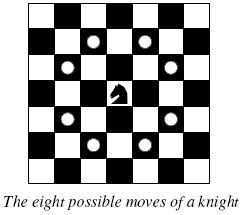快速切题 poj2488 A Knight's Journey
A Knight's Journey
| Time Limit: 1000MS | Memory Limit: 65536K | |
| Total Submissions: 31195 | Accepted: 10668 |
Description
 Background
Background The knight is getting bored of seeing the same black and white squares again and again and has decided to make a journey
around the world. Whenever a knight moves, it is two squares in one direction and one square perpendicular to this. The world of a knight is the chessboard he is living on. Our knight lives on a chessboard that has a smaller area than a regular 8 * 8 board, but it is still rectangular. Can you help this adventurous knight to make travel plans?
Problem
Find a path such that the knight visits every square once. The knight can start and end on any square of the board.
Input
The input begins with a positive integer n in the first line. The following lines contain n test cases. Each test case consists of a single line with two positive integers p and q, such that 1 <= p * q <= 26. This represents a p * q chessboard, where p describes how many different square numbers 1, . . . , p exist, q describes how many different square letters exist. These are the first q letters of the Latin alphabet: A, . . .
Output
The output for every scenario begins with a line containing "Scenario #i:", where i is the number of the scenario starting at 1. Then print a single line containing the lexicographically first path that visits all squares of the chessboard with knight moves followed by an empty line. The path should be given on a single line by concatenating the names of the visited squares. Each square name consists of a capital letter followed by a number.
If no such path exist, you should output impossible on a single line.
If no such path exist, you should output impossible on a single line.
Sample Input
3 1 1 2 3 4 3
Sample Output
Scenario #1: A1 Scenario #2: impossible Scenario #3: A1B3C1A2B4C2A3B1C3A4B2C4
实际用时 20min
情况:CCCCA 注意java和胡乱改动
注意点:1 组间空行但最后一组没有 2 字典序
#include <cstdio>
#include <cstring>
using namespace std;
int n,m;
typedef unsigned long long ull;
bool used[8][8];
char heap[64][3];
const int dx[8]={-2,-2,-1,-1,1,1,2,2},dy[8]={-1,1,-2,2,-2,2,-1,1};
bool judge(int x,int y){
if(x>=0&&x<n&&y>=0&&y<m)return true;
return false;
}
bool dfs(int x,int y,int cnt){
used[x][y]=true;
heap[cnt][0]=x+'A';
heap[cnt++][1]=y+'1';
if(cnt==n*m)return true;
for(int i=0;i<8;i++){
int tx=x+dx[i],ty=y+dy[i];
if(judge(tx,ty)&&!used[tx][ty]){
if(dfs(tx,ty,cnt))return true;
}
}
used[x][y]=false;
return false;
}
int main(){
int T;scanf("%d",&T);
for(int ti=1;ti<=T;ti++){
scanf("%d%d",&m,&n);
memset(used,0,sizeof(used));
bool fl=dfs(0,0,0);
printf("Scenario #%d:\n",ti);
if(fl){
for(int i=0;i<n*m;i++){
printf("%s",heap[i]);
}
puts("");
}
else {
puts("impossible");
}
if(ti<T)puts("");
}
return 0;
}



